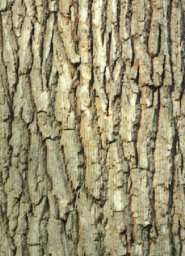Tanbark
Tanbark refers to the bark of certain species of trees that is used in the tanning of animal hides into leather. The term is also used to describe the ground-up bark used for various purposes, including as a surface for playgrounds and pathways.
Sources of Tanbark[edit | edit source]
Tanbark is typically derived from trees that have a high tannin content. Some of the most common sources of tanbark include:
Uses of Tanbark[edit | edit source]
The primary use of tanbark is in the tanning process, where the tannins in the bark are used to convert animal hides into durable leather. The process involves soaking the hides in a solution made from the bark, which helps to preserve the hides and make them more resistant to water and decay. In addition to its use in tanning, tanbark is also used as a mulch in gardening and landscaping. It helps to retain moisture in the soil, suppress weeds, and improve the overall appearance of garden beds. Tanbark is also used as a surface material for playgrounds, pathways, and horse arenas due to its cushioning properties.
Historical Context[edit | edit source]
Historically, the use of tanbark dates back to ancient civilizations, where it was an essential component in the production of leather goods. The Industrial Revolution saw a significant increase in the demand for leather, leading to the establishment of large-scale tanneries that relied heavily on tanbark.
Environmental Impact[edit | edit source]
The harvesting of tanbark can have significant environmental impacts, particularly when it involves the stripping of bark from live trees. This practice can lead to the death of the trees and contribute to deforestation. Sustainable practices, such as using bark from already felled trees or from managed forests, are essential to mitigate these impacts.
Modern Alternatives[edit | edit source]
In modern times, synthetic tanning agents have been developed, reducing the reliance on natural tanbark. These synthetic agents can offer more consistent results and are often more environmentally friendly. However, traditional tanbark is still valued for its natural properties and is used in artisanal and high-quality leather production.
See Also[edit | edit source]
References[edit | edit source]
External Links[edit | edit source]
Navigation: Wellness - Encyclopedia - Health topics - Disease Index - Drugs - World Directory - Gray's Anatomy - Keto diet - Recipes
Search WikiMD
Ad.Tired of being Overweight? Try W8MD's physician weight loss program.
Semaglutide (Ozempic / Wegovy and Tirzepatide (Mounjaro / Zepbound) available.
Advertise on WikiMD
WikiMD is not a substitute for professional medical advice. See full disclaimer.
Credits:Most images are courtesy of Wikimedia commons, and templates Wikipedia, licensed under CC BY SA or similar.Contributors: Prab R. Tumpati, MD






